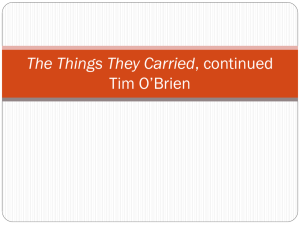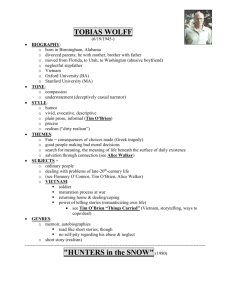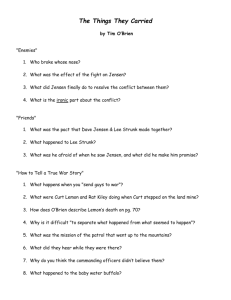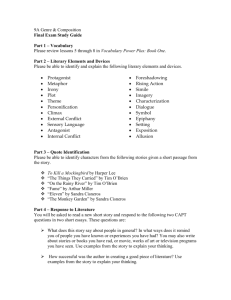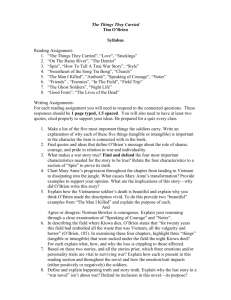The Things They Carried Study Guide: Discussion Questions
advertisement
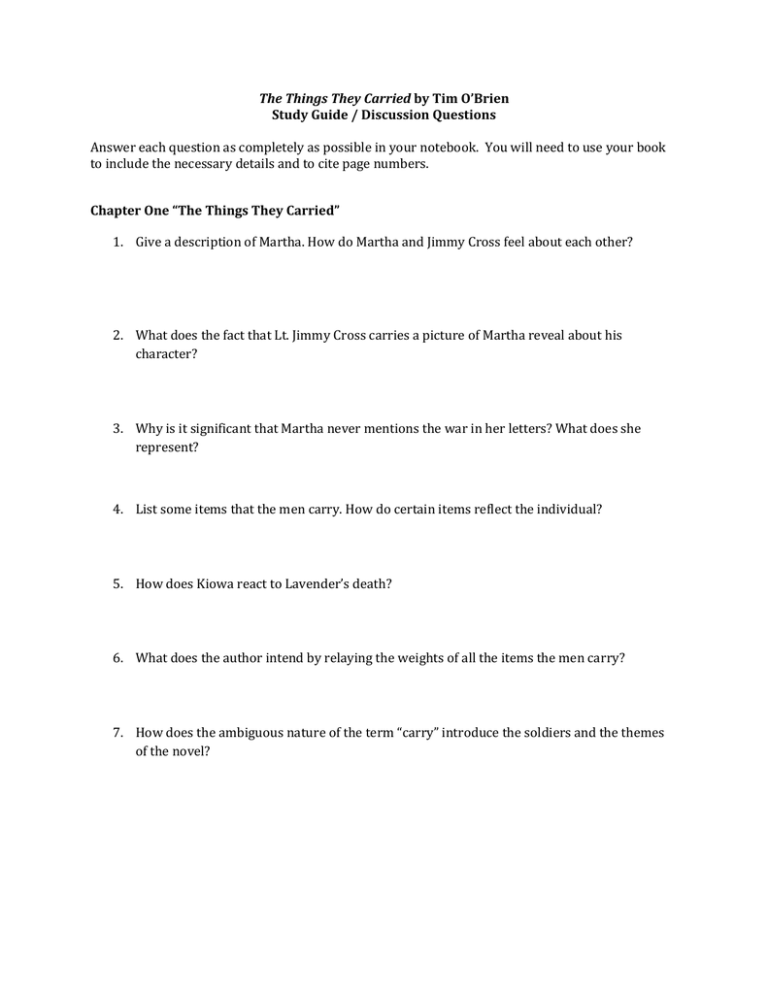
The Things They Carried by Tim O’Brien Study Guide / Discussion Questions Answer each question as completely as possible in your notebook. You will need to use your book to include the necessary details and to cite page numbers. Chapter One “The Things They Carried” 1. Give a description of Martha. How do Martha and Jimmy Cross feel about each other? 2. What does the fact that Lt. Jimmy Cross carries a picture of Martha reveal about his character? 3. Why is it significant that Martha never mentions the war in her letters? What does she represent? 4. List some items that the men carry. How do certain items reflect the individual? 5. How does Kiowa react to Lavender’s death? 6. What does the author intend by relaying the weights of all the items the men carry? 7. How does the ambiguous nature of the term “carry” introduce the soldiers and the themes of the novel? Chapter 2: “Love” 1. What could Jimmy Cross never forgive himself for? 2. How did Jimmy get a new picture of Martha playing volleyball? 3. What does Jimmy ask Tim to do when he writes his story? 4. What does he tell Tim NOT to mention? 5. What does it tell us about Tim O’Brien, the narrator, that he reveals character traits of Cross’s that Cross would prefer to have remain unknown? Chapter 3: “Spin” 1. What do we learn about Azar’s character in this story? 2. How was the war NOT like a game of checkers? 3. How did the “old poppa-san” help the platoon? What was his special skill? 4. What does Norman Bowker wish for, more than anything? 5. What does Kiowa say when his rain dance doesn’t work? 6. What did Azar do to Ted Lavender’s puppy? 7. What does Azar say about his action? 8. Identify in this story moments of beauty and/or serenity. 9. How is this story structured? What can you say about all these short sections? 10. According to Tim, what are stories for? Chapter 4: “On the Rainy River” 1. How did Tim feel about the Vietnam War while he was at college? Do his actions and language support the idea that he “hated” the Vietnam war? 2. What were Tim’s options once he received his draft notice? Who did he hold responsible for his situation? Who did he think should go to war instead of him? 3. What does Tim say is Elroy Berdhal’s role in his life? What sort of person was Elroy? How did Tim know? 4. How do the opening sentences prepare you for the story?: “This is the one story I’ve never told before. Not to anyone.” What effect do they have on the reader? 5. Why does O’Brien relate his experience as a pig declotter? How does this information contribute to the story? Why go into such specific detail? 6. At the story’s close, O’Brien almost jumps ship to Canada, but doesn’t: “I did try. It just wasn’t possible.” What has O’Brien learned about himself, and how does he return home as a changed person? 7. In this chapter, we learn the 21-year-old O'Brien's theory of courage: “Courage, I seemed to think, comes to us in finite quantities, like an inheritance, and by being frugal and stashing it away and letting it earn interest, we steadily increase our moral capital in preparation for that day when the account must be drawn down. It was a comforting theory.” What might the 43-year-old O'Brien's theory of courage be? Chapter 5 “Enemies” 1. Why does Jensen claim there are “enemies everywhere”? 2. How does Dave Jensen’s reaction exemplify the fragile psychology of Vietnam soldiers? Chapter 6 “Friends” 1. Why has O’Brien placed this chapter immediately after the previous chapter, “Enemies”? What is the connection between the chapters? 2. What does the arrangement between Strunk and Jensen reveal about the soldiers in the platoon? What does the fact that Strunk begs Jensen not to fulfill his part of the agreement reveal about Jensen? About soldiers in general? 3. Why do Strunk and Jensen enter into their pact in the first place? Why does Strunk want to rescind the pact when he is injured? 4. Why is Jensen “relieved” to hear that Strunk has died? Chapter Seven “How to Tell a True War Story” 1. Discuss the opening line, “This is true.” How does this line prepare the reader for the story? 2. Who does Rat Kiley write a letter to? Why does he put so much detail and effort into the letter, and how does it make him feel when he doesn’t get a response? 3. Why do you think the author introduces the character of Curt Lemon through Rat’s letter? Why does he introduce him prior to telling the story of his death? Prior to telling us his name? 4. “If you don’t care for obscenity, you don’t care for the truth.” What do you make of this statement? What is O’Brien trying to tell us? (Tip: this chapter is FULL of though-provoking and discussion-worthy quotes. Choose a few that speak to or interest you and bring them up in discussion). 5. What makes the telling of the story of Curt Lemon’s death so powerful? Remember, O’Brien is trying to teach us something about how to tell stories well. What does he do to make this one, as well as the baby buffalo one, so powerful? 6. What does Mitchell Sanders’ story about the six men on the LP (listening post operation) tell us about the Vietnam War and the experience of the soldiers? (There is a lot to discuss here!) Chapter 9 “Sweetheart of the Song Tra Bong” 1. What was Rat’s reputation among the men of Alpha Company, when it came to telling stories? 2. What does Rat insist about his story in this chapter? 3. What was the military discipline like at the outpost? 4. Who were the Greenies and what were they like? 5. What does Rat say are the similarities between Mary Ann and all of them? 6. What did Mary Anne begin to do when casualties came in? What does this tell us about her? 7. Where had Mary Anne been the first time she stayed out all night? 8. How did she change as a result of her conversation with Fossie the next morning? 9. How did she respond to Fossie’s arrangements to send her home? Why, do you think? 10. When and under what circumstances did Rat see her next? 11. On pg. 106, what is Mitchell Sanders’ attitude about Rat’s way of telling a story? Why do you think it bothers him? 12. What does Rat have to say about the soldiers’ attitude toward women? 13. What do the Rat, Fossie, and Eddie find when they entered the Greenies’ hootch? 14. What kind of jewelry was Mary Anne wearing? What is significant about this? 15. What does Mary Anne tell Fossie about his presence in Vietnam? What does she realize? 16. What does Mary Anne say she wants to wants to do with Vietnam? What does this mean?? 17. Analyze the metaphor that Rat uses to explain Mary Anne’s experience with Vietnam. Chapter 10 “Stockings” 1. Thematically, why do you think O’Brien place this chapter immediately after the previous one? 2. In what way does the chapter “Stockings” differ from “Sweetheart of the Song Tra Bong” in the way the women are perceived? What seems to be the role of women for the men? 3. Why do you think his girlfriend’s breakup has no effect on the magical power of the stocking Henry Dobbins wears? What do the stockings (and his girlfriend) represent for him? Chapter 11 “Church” 1. Why does Kiowa come to believe that it is wrong to set up camp in the church? Questions for both “Stockings” and “Church” 1. “Stockings” is about superstition and “Church is about religion. How are these two seemingly contrasting notions very similar to the soldiers? 2. How does the notion of superstition (or religion) mirror the notion of truth in the novel? How are all these things alike in some way? 3. In what ways are Kiowa and Dobbins foil characters? (Foil characters have contrasting qualities meant to set off each other’s qualities). Chapter thirteen “Ambush” 1. O’Brien does not tell his nine-year-old daughter, Kathleen, that he killed someone in the war because it seems the right thing to do. Do you agree with him? Support your response. 2. O’Brien tells the same story twice; one version is brief and the other is detailed. How does this explain his comment, “This is why I keep writing war stories”? 3. O’Brien writes about throwing the grenade and killing the man, saying, “It was not a matter of live or die. There was no real peril. Almost certainly the young man would have passed by.” What is his reason for killing the man? Chapter 14 “Style” 1. What kind of literary device does the narrator use several times throughout this short chapter to describe the scene in the village where the young girl is dancing? What effect is created with this device? Chapter 15 “Speaking of Courage” 1. What point of view is used to convey the events in “Speaking of Courage”? Why is this important? 2. What are the levels of “courage” to which the title of this vignette refers? 3. How does Norman Bowker experience his hometown after returning to it after the end of the war? 4. What might be significant about the fact that the story takes place on the 4th of July? 5. What might the lake that Norman dives around symbolize? What about the idea of going in a circle? 6. Pay close attention to contrasts in this chapter. What contrasts do you observe, and what is the impact of the contrasts on the reader? Chapter 16 “Notes” 1. How does this chapter build upon the previous chapter’s theme of isolation and alienation? 2. How does the chapter contribute to the theme of guilt? Chapter 17 “In the Field” 1. Who is the predominant narrator in this chapter? 2. What is Azar’s coping mechanism for dealing with death? 3. What is the significance of the metaphor O’Brien uses to describe Jimmy Cross’s reaction to seeing his soldiers search for Kiowa’s body? 4. How does the chapter develop the themes of guilt and blame? 5. What other theme does O’Brien revisit in narrating Cross’s feelings on the morning after Kiowa’s death? 6. Why do you think Jimmy Cross seems to understand why it is so important for the young soldier to find the picture of his girlfriend? 7. What connection can you make between the letter to Kiowa’s family that Jimmy Cross keeps revising and the idea of storytelling to deal with guilt? 8. The narrator says, “When a man died, there had to be blame.” Who do you think is most to blame for Kiowa’s death, and why? Chapter 19 “Field Trip” 1. Why does O’Brien return to Vietnam? 2. Why does O’Brien return to the field? 3. What does O’Brien accuse the field of doing to him? Chapter 20 “The Ghost Soldiers” 1. Who is Bobby Jorgenson? 2. Why does Tim want to “get even” with him? 3. Why does Tim feel a “new sense of separation” from his friends? (See 194) 4. What kind of emotional changes does Tim experience after his accident? (200) 5. Why do they call the enemy “ghosts”? (202) 6. Who does Tim recruit to help him get his revenge? 7. What exactly is the plan for revenge—what do they do? 8. What happens to Azar during the revenge? 9. How does the story end? How have Jorgenson and Tim gotten closer? 10. What does"The Ghost Soldiers" add to the book that we have almost completed? Does it provide any new insights, perspectives, or experiences about any of the characters? What do you think its function in the overall narrative might be? Chapter 22: “Lives of the Dead” 1. In the first paragraph on page 225, Tim says that stories have a special power. What can they do? 2. How do the men in the company behave toward the dead body they find? What specific actions do they do? 3. What does the dead body remind Tim of? ___________________________________ 4. What was the premise of the movie that Tim saw on his first date? 5. What unusual piece of clothing did Linda wear to school? _______________________ 6. What secret did Nick reveal when he picked up his pencil? 7.What are some of the funny nicknames that the soldiers give to dead bodies? 8. Why do the soldiers use these nicknames or make jokes about the dead? 9. What kind of dreams does Tim have he visited the funeral parlor? 10. Reread the final paragraph of this book. Consider what the young Tim O'Brien learns about storytelling from his experience with Linda. How would you characterize Tim O'Brien's understanding of storytelling?
